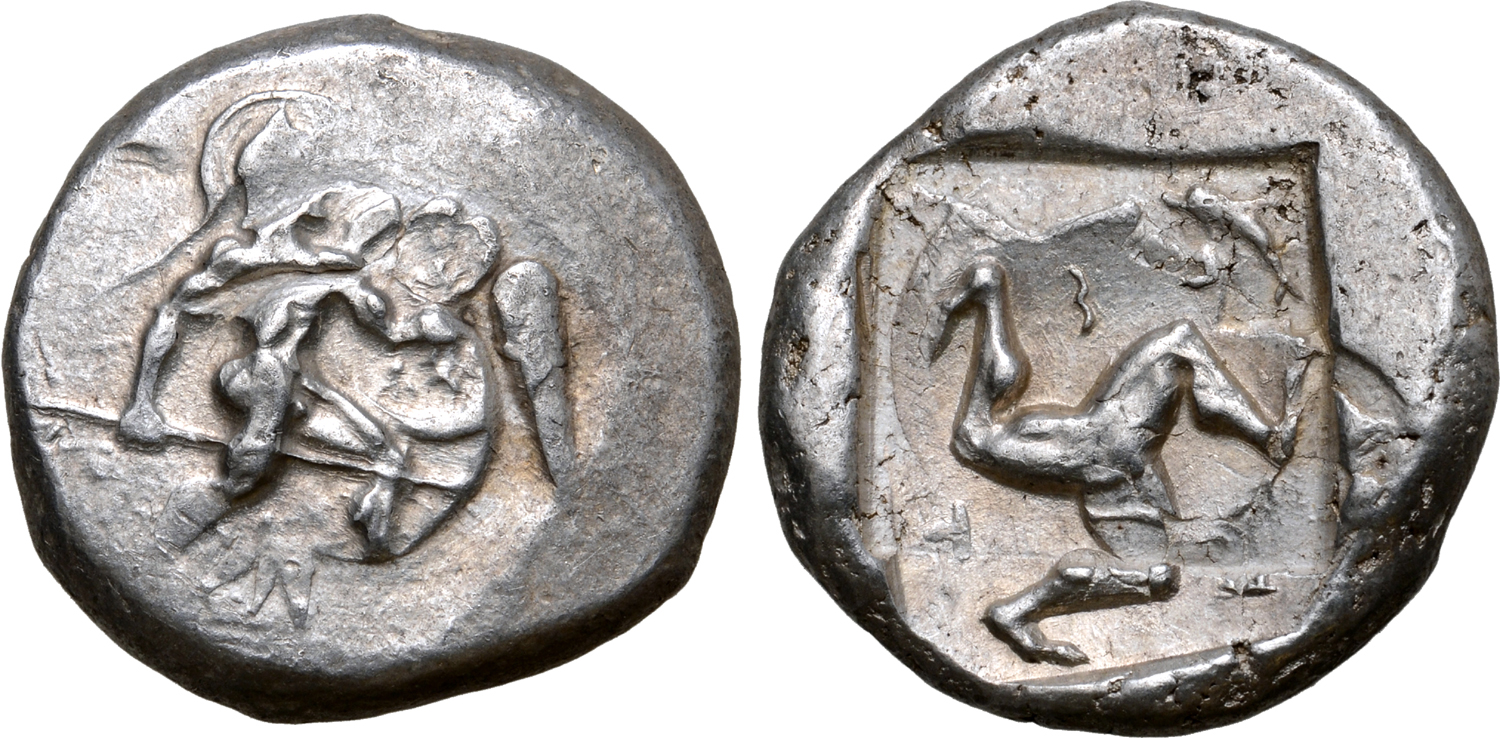2981 - Aspendus (double siglos hoplite/triskeles) over Side (pomegranate/Athena) (Roma Numismatics, XXI, March 2021, 252)
From SILVER
| Line 17: | Line 17: | ||
|Axis=1 | |Axis=1 | ||
|Denomination=stater | |Denomination=stater | ||
| − | |Coin series reference=Babelon 1901, Part 2, Tome 1, p. 526-530, n° | + | |Coin series reference=Babelon 1901, Part 2, Tome 1, p. 526-530, n° 869-70 ; SNG France 3, n° 12-13 |
| − | |Coin series web reference=https://greekcoinage.org/iris/id/ | + | |Coin series web reference=https://greekcoinage.org/iris/id/aspendus_babelon_1907_869-70 |
|Overstruck mint=Side | |Overstruck mint=Side | ||
|Overstruck ancient region=Pamphylia | |Overstruck ancient region=Pamphylia | ||
|Overstruck denomination=stater | |Overstruck denomination=stater | ||
}} | }} | ||
Revision as of 16:07, 28 July 2023
465 BCE - 430 BCE | ΕΣTF
Images
Overstriking coin

SO 848 - Aspendus (stater hoplite-triskeles).jpeg [1]
Location/history
| Sale(s)Sale(s) ᵖ: | Roma Numismatics, XXI, 24 March 2021, 252 | |
Overstriking coin
Description
| ObverseInscription or printing placed on the obverse.: | Hoplite advancing right, nude, wearing helmet, holding spear and shield | ReverseInscription or printing placed on the reverse.: | ΕΣTF (Greek) Triskeles within incuse square |
Mint and issuing power
| MintIdentifies the place of manufacture or issue of a numismatic object.: | Aspendus | Ancient regionAncient region. | Pamphylia | Modern countryModern country: Turkey | AuthorityIdentifies the issuing power. The authority can be "pretended" when the name or the portrait of X is on the coin but he/she was not the issuing power. It can also be "uncertain" when there is no mention of X on the coin but he/she was the issuing power according to the historical sources: |
Chronology
| FromIdentifies the initial date in a range assigned in a numismatic context. 465 BCE toIdentifies the final date in a range assigned in a numismatic context.. 430 BCE | Classical 480-323 BC |
Physical description
| MetalThe physical material (usually metal) from which an object is made.: Silver |
WeightWeight of the numismatic object (in grams). in grams: 10.810.8 g <br />10,800 mg <br /> | DenominationTerm indicating the value of a numismatic object. Examples: tetradrachm, chalkous, denarius.: stater |
AxisDescribes the directional relationship between the obverse and reverse of a numismatic object.: 11 mm <br />0.1 cm <br /> |
| DiameterDescribes diameter of an object (in mm).: 2323 mm <br />2.3 cm <br /> | |||
References
| Coin referenceReference of the Coin: | Coin series referenceReference to coin series study: | Babelon 19011Babelon 1901, Part 2, Tome 1, p. 526-530, n° 869-70, SNG France 32SNG France 3, n° 12-13 | |
| Coin series web referenceCoin series web references: | |||
Overstruck type
Description
| ObverseInscription or printing placed on the obverse.: | ReverseInscription or printing placed on the reverse.: |
Mint and issuing power
| MintIdentifies the place of manufacture or issue of a numismatic object. ᵖ: | Side | Ancient regionAncient region. ᵖ | Pamphylia | Modern countryModern country: Turkey | AuthorityIdentifies the authority in whose name (explicitly or implicitly) a numismatic object was issued. ᵖ: |
Chronology
| FromIdentifies the initial date in a range assigned in a numismatic context. toIdentifies the final date in a range assigned in a numismatic context.. | periodTime period of the numismatic object. |
Physical description
| DenominationTerm indicating the value of a numismatic object. Examples: tetradrachm, chalkous, denarius. ᵖ: | stater |
References
| Coin type referenceReference to coin series study ᵖ: |
Additional data
| Frequency of overstrikesFrequency of overstrikes: | Level of confidenceLevel of confidence of the identification: | ||
| RemarksRemarks: | |||
References
- ^ Babelon, Ernest (1901), Traité des monnaies grecques et romaines. Tome Premier. Première partie, théorie et doctrine, Paris, E. Leroux
- ^ Levante, Edoardo [with the collaboration of Peter Weiss] (2001), Sylloge nummorum graecorum. France. 3, Département des monnaies, médailles et antiques : Pamphylie, Pisidie, Lyaconie, Galatie, Paris-Zürich, Bibliothèque nationale de France-Numismatica Ars Classica, XXXIV + 293 p. and 146 pl.